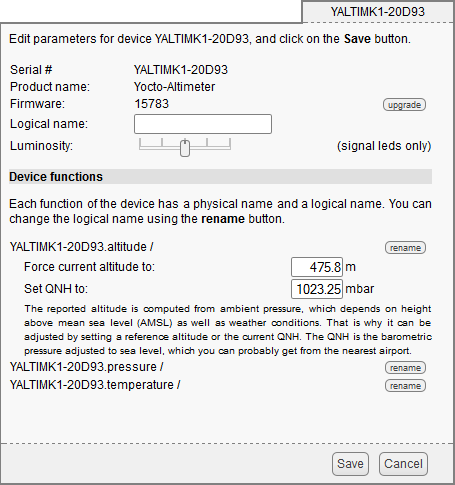 The Yoctopuce module family welcomes a new member: the Yocto-Altimeter. As you'll have guessed, it's a barometric altimeter allowing you to determine the altitude (or the relative height) of its location. Some of you already used the barometer of the Yocto-Meteo as an altimeter, but this new module provides much better measures.
The Yoctopuce module family welcomes a new member: the Yocto-Altimeter. As you'll have guessed, it's a barometric altimeter allowing you to determine the altitude (or the relative height) of its location. Some of you already used the barometer of the Yocto-Meteo as an altimeter, but this new module provides much better measures.

The Yocto-Altimeter
Measuring altitude
There aren't many methods to measure altitude, because there are few possible reference points for the measure.
- When what we are truly interested in is the height with regards to the ground, we can measure it with a radar, with a sonar, or with a laser telemeter. But this method works only at a low height, and doesn't provide an absolute measure. It can't be used inside a building, for instance.
- Outside, we can measure the distance to the sky (to satellites) with a GPS. Unfortunately, it's a very imprecise measure that works only when there is direct visibility with several satellites, without echo. In particular, it doesn't work well in the mountains or inside.
- In most cases, we can estimate the absolute altitude and quite precisely measure changes in altitude by an atmospheric pressure measure. Indeed, the higher you go in the atmosphere, the lower the pressure. This works also inside buildings (with some rare exceptions such as overpressured clean rooms).
The Yocto-Altimeter therefore uses the barometric method to measure altitude. Thanks to the sensitivity of its digital pressure sensor, the module can detect altitude changes of the order of 25cm only. Naturally, this doesn't mean that when you take the Yocto-Altimeter out of its wrapping it will provide you with your altitude to the nearest 25cm. For an absolute altitude measure, you must first provide it with a comparison point.
There are two ways to set the reference of a barometric altimeter. The first one consists in providing the initial altitude (which must be known), and then in using the altimeter to measure changes in altitude. Precision is then very good, as long as weather conditions don't change significatively.

You can configure a reference altitude or a reference pressure in the Yocto-Altimeter
The second method consists in indicating to the altimeter the current reference pressure, actually the pressure at sea level with the same weather conditions, and then in asking the altimeter an absolute altitude estimate. It's the method used in aeronautics to recalibrate the altimeter while flying. This reference pressure is called QNH in aeronautics and you can obtain it an any time thanks to the weather information of the nearest airport (do a Google search on the airport code followed by QNH). The QNH is usually provided in millibar, which provides an absolute precision of the altitude estimate of the order of 8m. It's less than the accuracy of a relative measure, but it's already much better than a GPS estimate.
An example
As a quick demo application, here is how a Yocto-Altimeter connected to an Android phone can provide a vocal feedback to any elevator (as an aid system for the visually impaired), without having to interconnect it in any way with the elevator control system.


